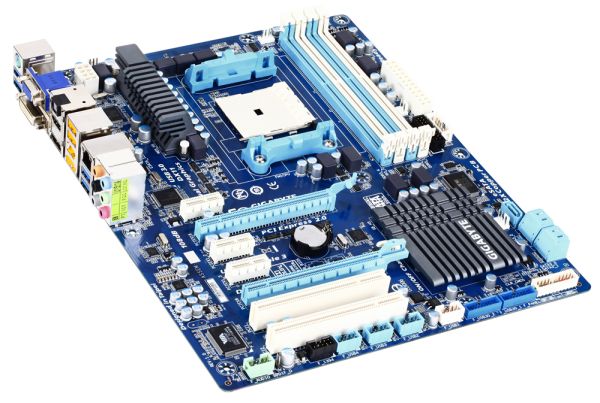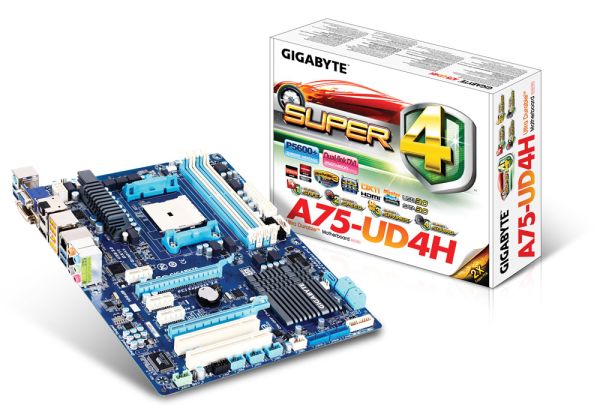ASUS F1A75-V Pro vs. Gigabyte GA-A75-UD4H – Llano at ~$120
by Ian Cutress on November 7, 2011 6:00 AM EST- Posted in
- Motherboards
- Gigabyte
- Asus
- A75
Overview of the Gigabyte GA-A75-UD4H
After having this board on the review test bed for a few days now, nothing immediately strikes me from the Gigabyte board. The overclock capability was quite good, despite the lack of overclock options.
The PCIe layout is a good one from which some other motherboard manufacturers can learn, and the IO panel is nicely full of USB ports. The position of the SATA port sticking out of the board, and the fan header next to it, is such that a second GPU will not hinder them. This also shows that some thought has gone to this area of the board!
I am quite disappointed by the fan control, especially compared to the ASUS board, which on this GA-A75-UD4H is limited in the BIOS and not expanded thoroughly by software in the OS. The BIOS is also still the old non-graphical style, and we’ll have to wait until X79 to get our hands on what Gigabyte has done in that respect.
At $115, the GA-A75-UD4H represents a board of good design, a three year warranty, but is let down by the options offered by software.
Visual Inspection
In terms of visuals, the GA-A75-UD4H sports a blue and white livery indicative of Gigabyte’s non-high end motherboards.
The 8+2 PWM design powers the large AMD socket, with VRM heatsinks which rock fairly easily under pressure. Around the socket are three fan headers, a SYS fan on the top left, a CPU fan in the top right and a PWR fan to the right of the DIMM slots. The socket area is fairly clear, allowing for large air coolers as required.
The GA-A75-UD4H sports a TPM header, and five SATA 6 Gbps ports. Four of these ports are at 90º to the board, and the other sticks out of it. The position of this port is such that if the user has two large PCIe cards in the board, this port is still accessible, as well as the SYS fan next to it.
The PCI/PCIe slot layout is a good choice for this board, with a PCIe x1 at the top, then a PCIe x16, two PCIe x1, another PCIe x16 (down to x8/x8 in dual GPU mode), and two PCI slots at the bottom. This allows sufficient space between dual GPU setups, as well as the top PCIe x1 for a first x1 card.
The IO panel is full of ports, namely 4 USB 3.0 (blue), two USB 2.0 (yellow), a PS/2 port, VGA, DVI-D, HDMI, DisplayPort, a S/PDIF optical output, an eSATA 6 Gbps port, FireWire, a Realtek gigabit Ethernet port, and typical audio jacks. I would have liked to see a Clear CMOS button, but with the IO this packed, I do not think there is space for it, unless they removed some features. It should be noted that, according to the Gigabyte website, the DVI-D does not support D-Sub by adaptor, and that when on integrated graphics, the connector cannot be changed while the motherboard is powered up.













47 Comments
View All Comments
Death666Angel - Monday, November 7, 2011 - link
Like he said, no reason to have that in a consumer product. If you need those controllers, buy server stuff. I haven't used a PCI card in my last 3 builds.PC13 - Saturday, November 12, 2011 - link
Just because you never needed them doesn't mean we don't. It's not your right to talk for everybody.Roland00Address - Monday, November 7, 2011 - link
I understand your point but those add on cards exist in a pci express option as well.http://www.newegg.com/Product/Product.aspx?Item=N8...
http://www.newegg.com/Product/Product.aspx?Item=N8...
knedle - Tuesday, November 8, 2011 - link
yeah, but it's cheaper to use your old card, than to buy a new one ;)also from time to time I make linux based routers, and they need two nics, it's a lot cheaper for me, to just add some $3 ethernet pci card, than buy something with pci express
oh! and don't forget those old scsii scanners, that some offices use, and they need cheap scsii pci card (or printers that need two way lpt port)
there is no harm in keeping those pci slots, so they just kept it, I'm pretty sure that if they were changet to pci express slots, there would be pci guys complaining ;)
Googer - Wednesday, November 9, 2011 - link
An INTEL brand PCI-e NIC can be bought for less than $30 on newegg. That's cheap.DanNeely - Tuesday, November 8, 2011 - link
Maybe, maybe not. Intel's removing it from some of their 7x series chipsets; and if the MSI x79 boards are an accurate indication, my prediction that most mobo vendors would initially add it back with bridge chips appears to be incorrect. If that's the case it'll disappear from all mainstream boards in the next year or three, although there will almost certainly be a few vendors that sell boards with it. You can get boards as recent as LGA1156 with ISA slots from industrial system vendors. (LGA1155 +ISA is probably still in design, a year ago when I looked the most recent I could find was LGA775.) Once you get into very low volume products the price gets ugly ($400 for an otherwise low end board); but thier target customers are using them to control legacy hardware with typical prices starting in the 5 figure range and soaring rapidly from therehttp://www.ibt.ca/v2/items/mb950/index.html
Googer - Wednesday, November 9, 2011 - link
IDE is available as a PCI-express addon. My Local CompUSA sells a bootable IDE add-on card in PCI-e for $29. I think it also had 2 usb ports as well. Not a bad deal.Googer - Wednesday, November 9, 2011 - link
What do you have that would still require PCI that you can't get in PCI-express?DanNeely - Monday, November 7, 2011 - link
Probably a limited number of PCIe lanes on the chipset.mariush - Monday, November 7, 2011 - link
People still use the pci slots for:* tv tuners (especially here in Europe where HD is not that popular),
* additional sata controllers
* sometimes SCSI controllers for some old scanners, firewire cards
* serial / parallel port controllers (not all usb to serial devices are good)
* sound cards (some still think soundblaster live sounds better than integrated cards)
* quality 100mbps network cards (connecting pc to a printer for example)
etc etc